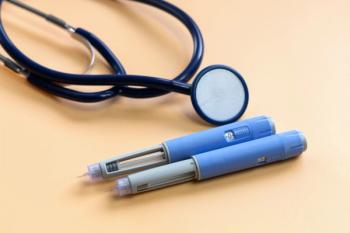
- October 2013 Diabetes
- Volume 79
- Issue 10
Diabetes Specialized Medication Therapy Management
The impact of the community pharmacist on insulin therapy is explored.
The impact of the community pharmacist on insulin therapy is explored.
Americans with diabetes can benefit from the clinical skills of their community pharmacists and access their local pharmacy for support in managing diabetes. Poor adherence with medication therapy has been shown to result in complications, increased health care costs, and death.1,2 Furthermore, patients using insulin reported dissatisfaction with ease of use, pain, and bruising, which also decreased compliance with therapy.3 With lack of proper instructions before injecting insulin, patients are at risk for lipohypertrophy, intramuscular (IM) injection, and poor glycemic control.4,5
Long hours of daily operation, availability of pharmacists without appointment, and the ability to speak the same language as their patients are several key features that make a community pharmacy well suited to provide education for individuals with diabetes. The lack of an existing diabetes program in the community led to the creation of a medication therapy management (MTM) program in diabetes at a community pharmacy in Brooklyn, New York, called Diabetes Care On-The-Go Inc. This diabetes program within the pharmacy itself was certified by the American Association of Diabetes Educators to improve diabetes care. To address the educational needs of the community, protocols and education sessions were created (Figure 1; Table 1).
Diabetes patients enrolled in the program benefited from face-to-face meetings with a PharmD, who was also a certified diabetes educator, and also from the group seminars that were provided. Based on the patient’s specific needs or interest, a patient could attend any group session and face-to-face meeting. Education was provided during evening and weekend “slow times” in the pharmacy. Each session discussed a different topic and allowed patients to discuss difficulties they encountered to medication compliance since the last visit.
During my tenure as a pharmacist, I was presented with numerous prescriptions for needles or syringes that simply stated the words “needles” or “syringes” without specifying length or gauge of the needle or syringe. The need for proper injection technique education created an opportunity for me as a pharmacist to provide the necessary information to improve patient care in my community.
During the injection technique seminar, I encountered many challenges to adherence with proper injection technique, including pain on injection, difficulty pushing the insulin once the needle was inserted, and lack of knowledge of appropriate injection sites. During the demonstration portion of the seminar and after following instructions, patients with arthritic pain in their hands found it easier to inject insulin using the 4 mm × 32 gauge BD Nano needle. Patients also reported that they felt less pain when they used the 4 mm × 32 gauge needle compared with longer needles. The 4 mm × 32 gauge needle also enabled patients to use a 1-hand, no-pinch technique; avoid IM injections; and use alternate sites for injection, including the stomach, arm, or thigh. Improvement in injection technique (Table 2) led to improvement in glycemic control for patients enrolled in the program and reduced the risk for hypoglycemia.
This Diabetes Specialized MTM program in a community pharmacy explored a new avenue for health support that is accessible and already linked to care because of patient’s continuous need for medications, supplies, and education. The program has shown to improve not only clinical outcomes for patients in the community, but also to increase customer loyalty and increase financial reimbursement to the pharmacy for MTM services provided.
Dr. Grossman is a board-certified diabetes educator and a patient aligned care team pharmacist in the primary care area at the New York VA Medical Center and the senior diabetes educator at Diabetes Care On-The-Go Inc. He serves as he corporate chair of the American Association of Diabetes Educator New Jersey coordinating body and as the advocacy chair and a member of the board of directors of the American Diabetes Association New Jersey community. He is a member of the chronic disease advisory board to the Commissioner of Health and Senior Services of New Jersey and is a faculty member at Hunter Bellevue School of Nursing (part of the City University of New York) and the University of Colorado Skaggs School of Pharmacy distance learning center. Dr. Grossman is the 2013 Specialty Pharmacist of the Year in the Next-Generation PharmacistTM award program and the 2012 Diabetes Educator of the Year of the American Association of Diabetes Educators New Jersey coordinating body. For his profile, go to www.PharmacyTimes.com Next Gen.
References
- Sest BL, Achusim LE, Genest RP, et al. Practical approach to determining costs and frequency of adverse events in health care network. Am J Health Syst Pharm. 2001;58:1126-1132.
- McDonnell PJ, Jacob MR. Hospital admissions resulting from preventable drug interactions. Ann Pharmacother .2002;36:1331-1336.
- Peyrot M, Rubin R, Kruger D. Correlates of insulin injection omission. Diabetes Care. 2010;33(2):240-245.
- De Coninck C, Frid A, Gaspar R, et al. Results and analysis of the 2008-2009 Insulin Injection Technique Questionnaire survey. J Diabetes. 2010;2:168-179.
- Volkova NI, Davidenko Yu. Lipohypertrophy in patients receiving insulin therapy: state of the art. Diabetes Mellitus. 2011;2:86-89.
Articles in this issue
about 12 years ago
Pet Peevesabout 12 years ago
Case Studiesabout 12 years ago
Can You Read These Rxs?about 12 years ago
Dangerous Liaisons: Obesity and Diabetesabout 12 years ago
Type 2 Diabetesabout 12 years ago
Opportunities for Improving Outcomes with Insulin Injectionsabout 12 years ago
Health App Wrapabout 12 years ago
First Exposure to Solid Food May Predict Type 1 Diabetes in InfantsNewsletter
Stay informed on drug updates, treatment guidelines, and pharmacy practice trends—subscribe to Pharmacy Times for weekly clinical insights.


















































































































































































































